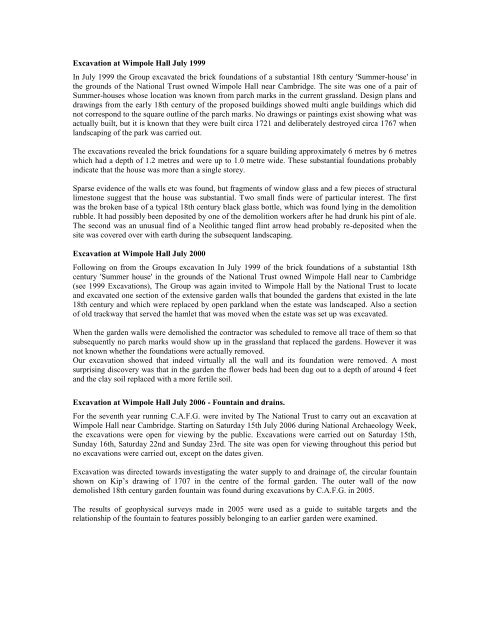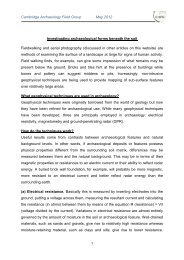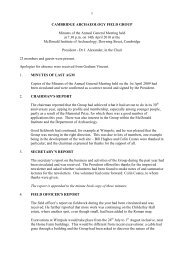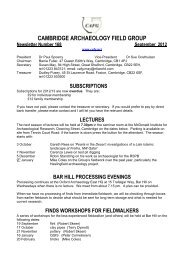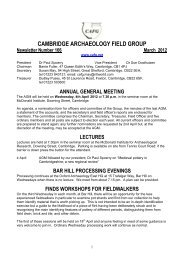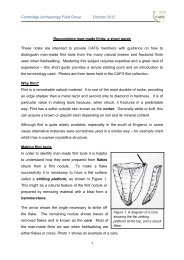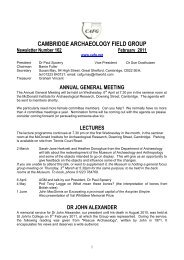Earlier excavations - Cambridge Archaeology Field Group
Earlier excavations - Cambridge Archaeology Field Group
Earlier excavations - Cambridge Archaeology Field Group
Create successful ePaper yourself
Turn your PDF publications into a flip-book with our unique Google optimized e-Paper software.
Excavation at Wimpole Hall July 1999<br />
In July 1999 the <strong>Group</strong> excavated the brick foundations of a substantial 18th century 'Summer-house' in<br />
the grounds of the National Trust owned Wimpole Hall near <strong>Cambridge</strong>. The site was one of a pair of<br />
Summer-houses whose location was known from parch marks in the current grassland. Design plans and<br />
drawings from the early 18th century of the proposed buildings showed multi angle buildings which did<br />
not correspond to the square outline of the parch marks. No drawings or paintings exist showing what was<br />
actually built, but it is known that they were built circa 1721 and deliberately destroyed circa 1767 when<br />
landscaping of the park was carried out.<br />
The <strong>excavations</strong> revealed the brick foundations for a square building approximately 6 metres by 6 metres<br />
which had a depth of 1.2 metres and were up to 1.0 metre wide. These substantial foundations probably<br />
indicate that the house was more than a single storey.<br />
Sparse evidence of the walls etc was found, but fragments of window glass and a few pieces of structural<br />
limestone suggest that the house was substantial. Two small finds were of particular interest. The first<br />
was the broken base of a typical 18th century black glass bottle, which was found lying in the demolition<br />
rubble. It had possibly been deposited by one of the demolition workers after he had drunk his pint of ale.<br />
The second was an unusual find of a Neolithic tanged flint arrow head probably re-deposited when the<br />
site was covered over with earth during the subsequent landscaping.<br />
Excavation at Wimpole Hall July 2000<br />
Following on from the <strong>Group</strong>s excavation In July 1999 of the brick foundations of a substantial 18th<br />
century 'Summer house' in the grounds of the National Trust owned Wimpole Hall near to <strong>Cambridge</strong><br />
(see 1999 Excavations), The <strong>Group</strong> was again invited to Wimpole Hall by the National Trust to locate<br />
and excavated one section of the extensive garden walls that bounded the gardens that existed in the late<br />
18th century and which were replaced by open parkland when the estate was landscaped. Also a section<br />
of old trackway that served the hamlet that was moved when the estate was set up was excavated.<br />
When the garden walls were demolished the contractor was scheduled to remove all trace of them so that<br />
subsequently no parch marks would show up in the grassland that replaced the gardens. However it was<br />
not known whether the foundations were actually removed.<br />
Our excavation showed that indeed virtually all the wall and its foundation were removed. A most<br />
surprising discovery was that in the garden the flower beds had been dug out to a depth of around 4 feet<br />
and the clay soil replaced with a more fertile soil.<br />
Excavation at Wimpole Hall July 2006 - Fountain and drains.<br />
For the seventh year running C.A.F.G. were invited by The National Trust to carry out an excavation at<br />
Wimpole Hall near <strong>Cambridge</strong>. Starting on Saturday 15th July 2006 during National <strong>Archaeology</strong> Week,<br />
the <strong>excavations</strong> were open for viewing by the public. Excavations were carried out on Saturday 15th,<br />
Sunday 16th, Saturday 22nd and Sunday 23rd. The site was open for viewing throughout this period but<br />
no <strong>excavations</strong> were carried out, except on the dates given.<br />
Excavation was directed towards investigating the water supply to and drainage of, the circular fountain<br />
shown on Kip’s drawing of 1707 in the centre of the formal garden. The outer wall of the now<br />
demolished 18th century garden fountain was found during <strong>excavations</strong> by C.A.F.G. in 2005.<br />
The results of geophysical surveys made in 2005 were used as a guide to suitable targets and the<br />
relationship of the fountain to features possibly belonging to an earlier garden were examined.
16th July 2006<br />
So far we have found two sections of the foundations of the outer wall on the Northern side of the<br />
Fountain pond either side of the centre line of the gardens. The section in between is missing and appears<br />
to be where the pipe feeding the Fountain/Pond entered. No pipe remains but as this was probably lead<br />
and valuable it would have been salvaged at the time of demolition of the Fountain/Pond. Adjacent to this<br />
entry point, but not directly connected to the outer wall foundations, are the foundations of an<br />
approximately square brick enclosure, which seems to be either a sump or a housing for control valves<br />
etc.<br />
29th July 2006<br />
Further work over the weekend of 22/23rd revealed the full extent of the walls of the sump enclosure, and<br />
exposed the water inlet pipe. A small fragment of a wood plank was found at the bottom of the existing<br />
excavation in the enclosure. There are no theories yet as to what it might be.<br />
The inlet pipe further excavated, revealing the small diameter lead pipe, which has a flange on the lower<br />
right end. It is not now connected to the main inlet pipe, but may have been in past. There was also a<br />
single brick course shelf running around the enclosure which may have supported a wooden cover.<br />
Other points of interest are:-<br />
The small flanged pipe of the inlet appears to have been sawn at it’s end, so what was connected to it and<br />
between it and the entrance to the main pond? Was there a control valve there? Did the enclosure have<br />
other functions? Why is the enclosure so large and substantial? Did the enclosure have a brick roof?<br />
The brickwork of the outer walls of the pond is in Flemish Bond, but the walls of the enclosure are a<br />
mixture of Flemish and English bond. This, plus the fact that the enclosure is not integral with the pond<br />
outer wall, probably indicates that the enclosure was built later than the pond outer wall and by a different<br />
builder.<br />
Excavation at Wimpole Hall July 2007<br />
With the agreement of Angus Wainwright, East of England archaeologist for the National Trust, we<br />
further explored the features seen on the geophysics at Wimpole Hall. Two main trenches were placed<br />
over features thought to be earlier than the fountain. In one trench we saw again the drain from the<br />
fountain, broken brick filling a trench on the line of east-west features seen on the geophysics and a<br />
square brick foundation, perhaps for a statue. The second trench revealed a substantial brick wall that may<br />
be part of a walled garden predating the fountain (i.e. c1680s). The archaeological outcome was a<br />
significant contribution to our understanding of the structures remaining under the grass of the Park;<br />
certainly they suggest that Thomas Chicheley built an enclosed garden to go with his new house in the<br />
1640s.<br />
Members of the <strong>Group</strong> had the experience and, we hope pleasure, of the excavation and at least 500<br />
people visited the site over the days we were there.<br />
Excavation at Wimpole Hall July 2008<br />
In July we were back at Wimpole to investigate further the features we believe are from the garden built<br />
by Thomas Chicheley in the 1640s. Much hard work showed the drain from the fountain cutting through<br />
the earlier walls, unfortunately it had destroyed the junction of these walls making phasing very difficult.<br />
But we have established that there is at least one period of rebuilding of these earlier walls and that this is<br />
the same relationship which we saw in trenches in 2006 and 2007. It is reasonably certain that we are<br />
exploring previously unrecorded garden features.
Excavation at Wimpole Hall July 2009<br />
We were pleased to welcome several local students to the 2009 <strong>excavations</strong>, including two of the 2009<br />
Val Whittaker prize-winners, who were at various stages of their university studies in archaeology. They<br />
certainly helped to lower the average age of the team quite considerably, while gaining valuable practical<br />
experience.<br />
This year will be remembered as the 'Year of the Shark's teeth' (two shark's teeth were recovered from<br />
the brick fill). They may originate from the underlying Gault clay, or perhaps from <strong>Cambridge</strong>shire<br />
greenshale sands, brought in to make up the garden paths.


